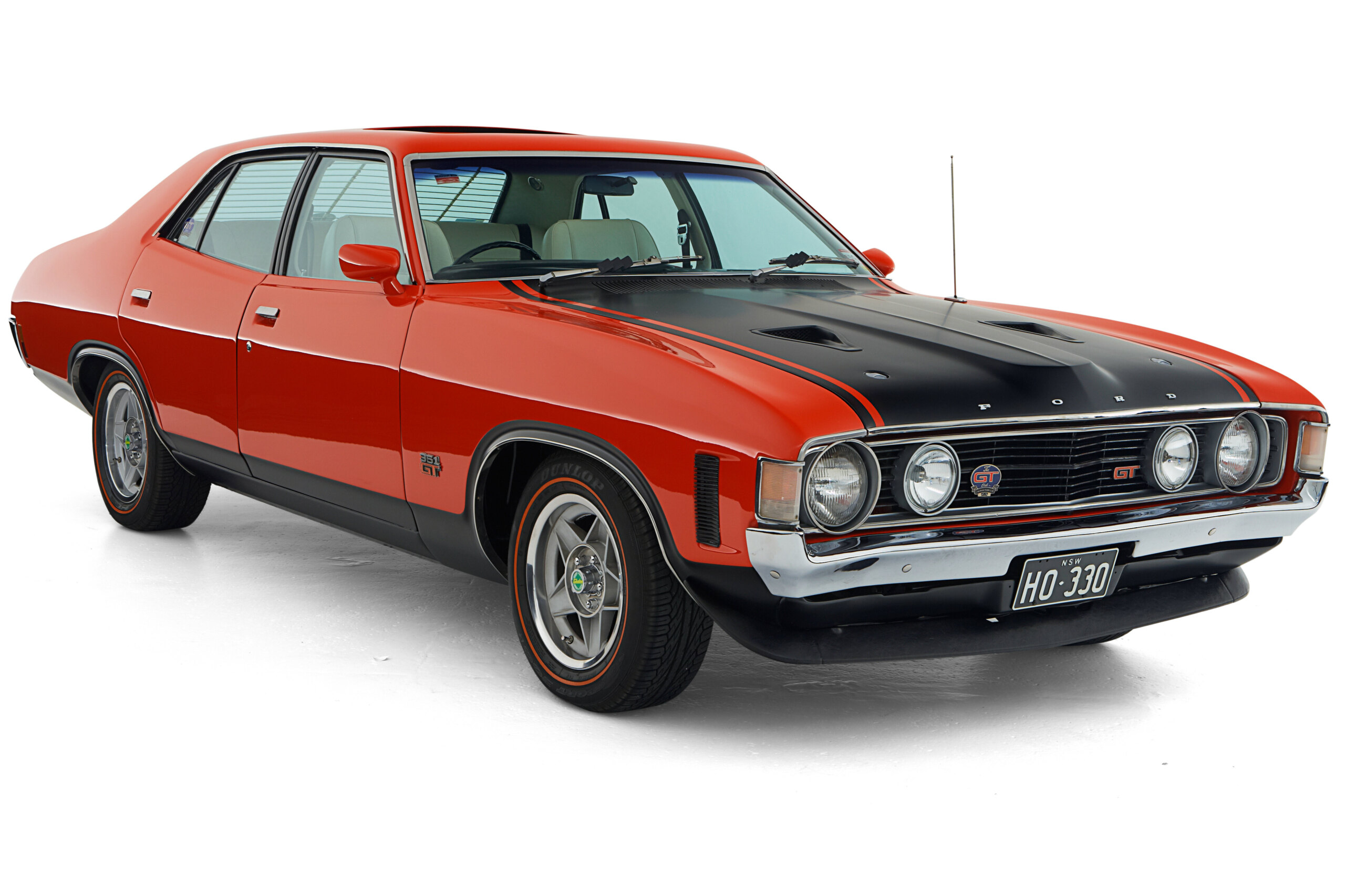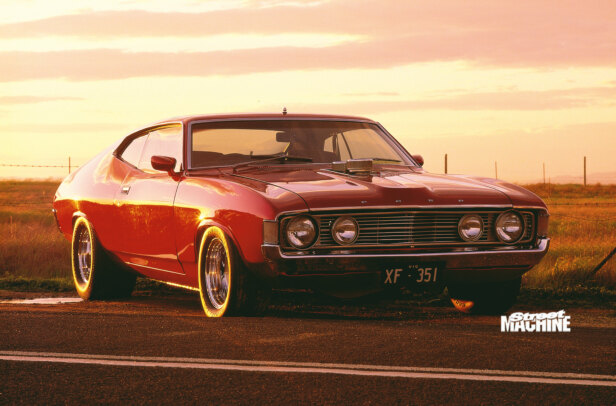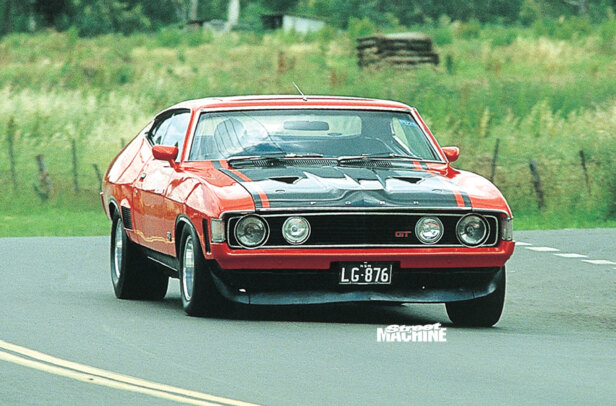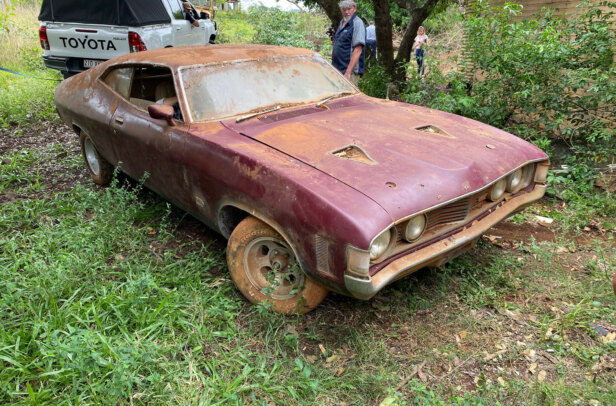If the XY GT-HO Phase III was the giddy climax of Ford muscle, the XA Falcon was the long-drawn cigarette afterwards. It still packed 351 Clevo inches in GT guise but the promised Phase IV was no more than a wet patch on the sheets in the wake of ill-informed pressure from the nanny state and media.
Far more significantly, Ford Australia introduced a new model that was not only its most successful Falcon but also a design that was, for the first time, 100 per cent dinky-di Australian. There were no reworked US hand-me-down panels for this baby, after Ford Oz successfully argued the cut-down Torino that FoMoCo was pushing for would look crap.
Head office in Dearborn told Ford Australia in 1968 that the US Falc was going the way of the dodo, so there’d be no US parent model to use as a basis. That might have spelt doom for the Falcon in Australia — even though the model was finally giving Holden a headache in the showroom— if not for the enthusiasm of local Ford honcho Bill Bourke and his US compatriot Jack Telnack, who was Ford Australia’s head of design.
These young guys (Bourke was 40) were not going to let the Falcon stop at eight incarnations and Telnack’s team came up with drawings that they took to experienced US clay modellers at the Ford Design Centre in Dearborn. There they designed a sedan, a wagon that featured a longer wheelbase for the first time, and a stretched Fairlane. All earned kudos from FoMoCo president Semon ‘Bunkie’ Knudsen — not bad for a small satellite operation and an indication of the standing Bourke had in the larger company.
But what wasn’t to like? The XA (along with the XB and XC) is arguably Ford Australia’s sexiest shape. The accentuated hip-line, sloping bonnet and pumped guards made it distinct from all that had come before. The shape followed the local company’s bold new attitude towards muscular large family cars, with a healthy dollop of Mustang DNA thrown in, and marked the start of a long tradition of uniquely Australian Fords.
Every panel was new; only the driveline and floorpan were carried over from the XY. Around it, the XA body was two inches longer and a fraction over an inch wider than the outgoing XY, while the wheel track was also widened to improve stability.
Inside, Ford took that jetliner dash, with all its knobs and gauges, and wrapped it around the driver, who now sat in a deep bucket and wondered why the hell they made it so hard to see out the back. The high waist, which made it look so fantastic from the outside, meant that you had to pretty much guess where your arse was when reverse parking.
Still, the interior drew appreciative oohs and ahhs for dropping all the controls within easy reach of the driver. There were extra dials and gauges with the GS pack, though those wanting to flick their fags through traditional quarter-vent windows had to choose them from a multitude of optional extras.
This was another area Ford successfully exploited, offering a broad mix of engine, transmission and trim options on an expanded body range that included utes and panel vans in Falcon, Falcon 500, Futura and Fairmont guises, with the GS and GT packages on top.
Engine choices were the same as the XY — the 3.3 (130hp) and single or double-barrel carbed 4.1 (170hp) sixes, plus the 4.9/302ci (240hp), and the 5.8/351ci (260hp) V8s, the latter with a two-barrel carb as standard or a four-barrel for the GT.
Meanwhile, the three-speed slushbox was made available across the board, as was the four-on-the-floor manual, though the three-on-the-tree cog-swapper was not an option with the 351.
The hardtop hit showrooms in August 1972, five months after the four door, and was the last of the big coupes to be released by the Big Three. With Australia’s small population, wise heads within Ford argued that the business case for the two-door wasn’t viable but thankfully passion won out.
The base model coupe cost $3195, $175 more than the equivalent four door. If you wanted the full-fruit GT, that would set you back $4955 (the GT sedan was $4790). For that you got a 600cfm four-barrel Holley, the reintroduced 12-slotters, three-speed FMX auto option, MacPherson struts, tacho, oil pressure gauge, high-back bucket seats and twin driving lights.
The icing on the cake should have been the Phase IV but it was killed by 1972’s supercar scare, sparked by Evan Green’s infamous Sun Herald story on 25 June.
The Phase IV was to have met the V8 LJ Torana and four-speed V8 Charger at Bathurst that year but all three cars were canned under government pressure. That meant Ford had to go back to the mountain with Phase III Falcons, which were defeated in wet weather by Peter Brock’s GTR XU-1. It was the last Great Race to be run under Series Production rules — the Group C rules that followed allowed the race cars to be modified from factory spec, rendering homologation specials like the Phase IV unnecessary.
Nevertheless, Ford was left with a whole pile of Phase IV parts — including the 780cfm carb, exhaust headers, 8000rpm tacho, winged sump and 6in Bathurst Globes — and decided to dispose of them through the RPO (Regular Production Option) 83. The RP0 83 was sold as an option on XA GTs, but without any marketing fanfare. It is thought that 252 of them were built, with 131 sedans and 121 coupes.
Some of the Phase IV bits also made it into the Group C hardtops for 1973 and delivered immediate success, with victory at Bathurst for Allan Moffat and Ian Geoghegan and another win in the 1974 race with John Goss and Kevin Bartlett behind the wheel.
By then Bill Bourke had moved up the management ladder, leaving new Ford Oz managing director Brian Inglis to accept the plaudits this bold new car was earning on and off the track.
That’s luxury
Ford responded to challenges from the HQ Statesman and the Chrysler by Chrysler with the XA-based ZF Fairlane. The ZF retained the same wheelbase as the ZD, but with a wider track, more body width and additional interior room. Visually, the ZF looked like a large XA, with the Fairlane’s quad headlamps moved back to a horizontal format within a full width grille. The 500 (pictured above) came with wheel arch moulds and a chrome strip below the doors. The line-up still consisted of two models; the Custom and the 500. Driveline specs were the same — 4.1 six and three-speed manual for the Custom, 4.9 V8 and auto in the 500 and optional for the Custom, and the 351 optional in both.
Power-assisted front discs were stock, as was power steering on the 500. Interior appointments included high-back bucket seats and retractable front seatbelts. The options list included such goodies as air con, sliding sunroof, cloth trim four-speaker radio/tape player and tinted glass. Priced at $3900 and $4790 respectively, they were cheap luxury.
XA GT – Peter Gianakoulias
A good condition XA GT 351 is rare but when Sydney’s Peter Gianakoulias did a little investigating he discovered this example — which he bought five years ago — was rarer than most, thanks to the factory option white interior, sunroof, green glass, power steering, air conditioning, left side mirror and Bathurst Globes.
“There are only five of these around,” he says. “I’ve seen similar models but it’s all about the combination.” Quite a find, especially for the out-and-out Ford nut who has a particular passion for the brand’s golden age. “I just love the muscle car era,” he says. “I had an XW and an XB GT, and I’ll probably go for the XA RPO83 coupe if I can find a good one.” Whether he’ll find one with an owner prepared to part with it is another matter, but in the meantime he’s happy as the third owner of this restored to new XA GT.
“It’s a show car these days — it lives in the garage — but I drive it with the [GT] club once a month and it’s picked up a few trophies. “Will he ever part with it? “I’m just in love with it and will probably keep if for the kids. I’ve had a lot of offers — I paid $46,000 five years ago and I’ve had offers up to $110,000 but I’ve knocked them back. The money would be nice but I wouldn’t have this car.”




Comments